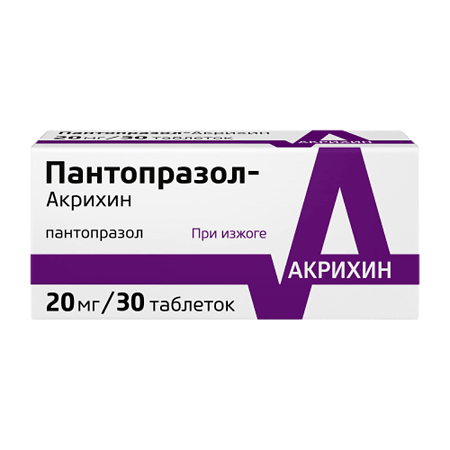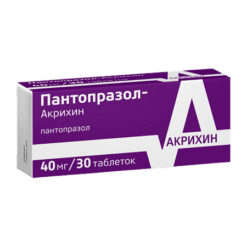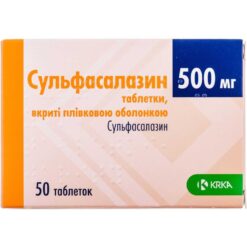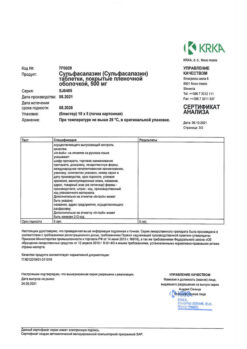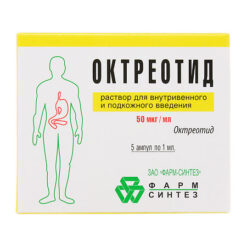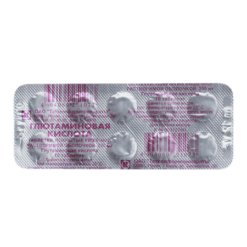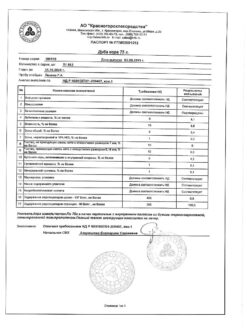No products in the cart.
Pantoprazol-Acrihin, 20 mg 30 pcs.
€11.35 €9.45
Description
Pharmacotherapeutic group: gastric gland secretion reducing agent proton pump inhibitor
ATC code: A02BC02.
Pharmacological properties
Pharmacodynamics
Proton pump inhibitor (H+ K+ ATPase). Blocks the final stage of hydrochloric acid secretion regardless of the nature of the stimulus.
Pantoprazole is a substituted benzimidazole that inhibits hydrochloric acid secretion in the stomach by specific blockade of the proton pumps of the parietal cells. Pantoprazole is transformed into its active form in an acidic environment in the parietal cells, where it inhibits the activity of the enzyme H+ K+ ATPase, i.e. it blocks the final step of hydrochloric acid formation in the stomach. The suppression of activity is dose-dependent and, as a result, both basal and stimulated acid secretion is reduced.
Pantoprazole treatment, as with other proton pump inhibitors and H2-receptor blockers, reduces gastric acidity and thereby increases gastrin levels in proportion to the decrease in acidity. The increase in gastrin levels is reversible. Because pantoprazole binds the enzyme distally to the cell receptor, it can inhibit hydrochloric acid secretion independently of stimulation by other substances (acetylcholine, histamine, gastrin).
Chromogranin A (CgA) is also increased in serum due to decreased hydrochloric acid secretion. Increased levels of CgA may distort the results of diagnostic tests to detect neuroendocrine tumors.
Antisecretory activity. After first oral administration of 20 mg of Pantoprazole-Acrihin, there is a 24% reduction in gastric juice secretion after 2.5-3.5 hours and a 26% reduction after 24.5-25.5 hours. After oral administration of pantoprazole once daily for 7 days, its antisecretory activity, measured 2.5-3.5 h after administration, increases to 56% and after 24.5-25.5 h to 50%. In duodenal ulcer associated with Helicobacter pylori, decreased gastric secretion increases the sensitivity of microorganisms to antibiotics. Does not affect the motility of the gastrointestinal tract. The secretory activity is normalized in 3-4 days after the end of intake.
In comparison with other proton pump inhibitors Pantoprazole-Acrihin has greater chemical stability at neutral pH, and less potential for interaction with the cytochrome P450-dependent liver oxidase system. Therefore, no clinically significant interactions have been observed between Pantoprazole-Acrihin and many other drugs.
Pharmacokinetics
Pantoprazole is rapidly absorbed after oral administration. The maximum plasma concentration (Cmax) with oral administration is reached after the first dose of 40 mg. On average, about 2-2.5 hours after the intake, the maximum serum concentration, about 1.0-1.5 mcg/ml and Cmax is reached and remains constant after multiple uses of this drug.
Pharmacokinetics of pantoprazole after single and multiple uses is the same. In the dose range of 10-80 mg, the pharmacokinetics of pantoprazole in plasma remains linear with both oral and intravenous administration.
The absolute bioavailability of pantoprazole tablets is about 77%. Concomitant ingestion has no effect on the area under the “concentration-time curve” (AUC), on the maximum serum concentration and, accordingly, on the bioavailability. When co-administration with food, the time of onset of action of the drug may vary.
The binding of pantoprazole to plasma proteins is 98%. The volume of distribution is 0.15 l/kg.
It is metabolized mainly in the liver. The main metabolic pathway is demethylation by CYP2C19 followed by sulfate conjugation. Other metabolic pathways include oxidation with CYP3A4.
The final elimination half-life is approximately 1 hour and clearance is approximately 0.1 L/h/kg. Due to the specific binding of pantoprazole to the proton pumps of the parietal cells, the elimination half-life does not correlate with a much longer duration of action (inhibition of acid secretion).
The main route of excretion is through the kidneys (about 80%) as metabolites of pantoprazole, the rest is excreted in the feces. The main metabolite in blood plasma and urine is desmethylpantoprazole, which is conjugated with sulfate. The elimination half-life of the main metabolite is about 1.5 h, which is slightly longer than that of pantoprazole.
In persons with low functional activity of the CYP2C19 isoenzyme (so-called slow metabolizers), pantoprazole is probably metabolized mainly by the CYP3A4 isoenzyme. After a single dose of pantoprazole 40 mg, the mean area under the concentration-time curve was approximately 6 times greater in slow metabolizers than in those with a functionally active CYP2C19 isoenzyme (fast metabolizers).
The mean values of maximum plasma concentrations were increased by approximately 60%. These characteristics do not affect the dosage of pantoprazole.
No dose reduction is required when using pantoprazole in patients with limited renal function (including patients on hemodialysis). As in healthy volunteers, the half-life of pantoprazole is short. Only a very small portion of the drug is dialyzed. Despite a moderately long elimination half-life of the main metabolite (2-3 h), its excretion is fast enough, and therefore accumulation does not occur.
In patients with liver cirrhosis (classes A and B according to Child-Pugh classification) the half-life period is increased to 3-6 hours, AUC values increase 3-5 times, the maximum concentration in serum increases insignificantly, only 1.5 times in comparison with that in healthy volunteers.
The slight increase of AUC and Cmax values in elderly persons in comparison with corresponding values in younger persons is not clinically significant.
Indications
Indications
Active ingredient
Active ingredient
Composition
Composition
How to take, the dosage
How to take, the dosage
Pantoprazole-Acrihin is taken orally, before meals, without chewing and crushing, with plenty of fluid.
Gastric and duodenal ulcers, erosive gastritis (including those associated with taking nonsteroidal anti-inflammatory drugs NSAIDs).
40-80 mg daily.
The course of treatment is 2 weeks in case of exacerbation of duodenal ulcer; if this time is not enough, healing can usually be achieved during the next 2 weeks of therapy. The course of treatment is 4-8 weeks for exacerbation of peptic ulcer disease and erosive gastritis.
Eradication of Helicobacter pylori.
The following combinations are recommended:
The course of treatment is 7-14 days.
Zollinger-Ellison syndrome.
For long-term treatment of Zollinger-Ellison syndrome and other pathological hypersecretory conditions, treatment should be started with a daily dose of 80 mg (2 Pantoprazole-Acrichin 40 mg tablets). Then, if necessary, the dose may be increased or decreased, depending on gastric acidity values. Doses above 80 mg per day should be divided and used twice daily. A temporary increase in the dose of pantoprazole above 160 mg is possible, but should not be continued longer than necessary to achieve control of acidity. The duration of treatment in Zollinger-Ellison syndrome and in other pathological hypersecretory conditions is not limited, and the duration of therapy may be determined according to clinical necessity.
In patients with significant hepatic dysfunction the daily dose of pantoprazole should not exceed 20 mg per day (1 tablet of pantoprazole 20 mg). Therefore, pantoprazole 40 mg is not recommended for this group of patients. Liver enzymes should be monitored regularly during treatment with pantoprazole, especially during long-term use. In case of elevated liver enzymes, treatment should be discontinued.
There is no need for dose adjustment in elderly patients and patients with renal impairment.
Because of the lack of data on the use of Pantoprazole-Acrihin in combination antimicrobial therapy against Helicobacter pylori in patients with impaired renal function and in patients with moderate to severe hepatic impairment, the drug should not be used.
Interaction
Interaction
The concomitant use of other proton pump inhibitors or H2-histamine receptor blockers without medical advice is not recommended.
The concomitant use of Pantoprazole-Acrihin may reduce absorption of drugs whose bioavailability depends on the pH of the stomach (e.g. ketoconazole, itraconazole, posaconazole and other medicinal products such as erlotinib).
The co-administration of pantoprazole and HIV protease inhibitors whose absorption depends on gastric acidity (pH), such as atazanavir, nelfinavir, significantly reduces their bioavailability.
In drug interaction studies, no clinically significant interactions have been found with pantoprazole drugs in the following cases:
It is also noted that there are no clinically significant drug interactions with caffeine, ethanol, theophylline.
There are reports of elevated blood levels of methotrexate in some patients when coadministered in high doses (e.g., 300 mg) with proton pump inhibitors. Therefore, when high doses of methotrexate are used, such as in cancer or psoriasis, it may be necessary to consider temporarily withdrawing pantoprazole.
CYP2C19 isoenzyme inhibitors such as fluvoxamine may increase systemic exposure to pantoprazole. Dose reduction may be necessary in patients receiving long-term treatment with high doses of pantoprazole or in patients with hepatic impairment.
Inducers of CYP2C19 and CYPJA4 isoenzyme activity, such as rifampicin and Hypericum perforatum, may decrease plasma concentrations of proton pump inhibitors metabolized by these enzyme systems.
HIV protease inhibitors.
Pantoprazole is not recommended for use with HIV protease inhibitors whose absorption is dependent on the pH of the gastric environment (e.g., atazanovir) because of a significant decrease in their bioavailability.
If co-administration of HIV protease inhibitors and proton pump inhibitors is still necessary, careful clinical monitoring (e.g., viral load determination) is recommended. The dose of pantoprazole should not exceed 20 mg daily. Adjustment of HIV protease inhibitor dosage may also be necessary.
Special Instructions
Special Instructions
Before treatment with Pantoprazole-Acrihin, the possibility of malignancy should be excluded, since the drug may mask symptoms and delay correct diagnosis.
Patients should consult their physician if they are to have an endoscopy or urea breath test.
Patients should consult a physician if the following conditions exist:
Patients over 55 years of age should consult a physician if they have any new or recently changed symptoms.
Patients should not expect immediate relief of symptoms. Relief of symptoms is possible after approximately one day of taking pantoprazole, and it should also be considered that it may take approximately 7 days for heartburn to completely resolve.
The use of drugs which decrease gastric acidity slightly increases the risk of gastrointestinal infections caused by Salmonella spp., Campylobacter spp. or C. difficile.
In patients with Zollinger-Ellison syndrome and other pathological hypersecretory conditions that require long-term treatment, pantoprazole, like other drugs that block gastric juice secretion, may decrease absorption of vitamin B12 (cyanocobalamin) due to hypo- and achlorhydria. This should be considered when treating patients with reduced stores of this vitamin in the body, or during long-term treatment of patients with risk factors for development of vitamin B12 deficiency, as well as when observing appropriate clinical symptoms.
Continuing long-term therapy, especially for more than 1 year, requires regular monitoring of patients.
Pantoprazole is not recommended for use with HIV protease inhibitors whose absorption is dependent on gastric pH (e.g., atazanovir) because their bioavailability is significantly reduced.
There have been reports of severe hypomagnesemia in patients who have received IPN for at least 3 months, and in most cases for up to a year. Serious manifestations of hypomagnesemia such as increased fatigue, tetany, delirium, seizures, dizziness and ventricular arrhythmias may occur, but hypomagnesemia may develop unnoticed and not recognized in time. In most patients with hypomagnesemia it decreases after magnesium replacement therapy and IPN withdrawal. In patients who are scheduled for long-term treatment or in patients receiving IPNs together with digoxin or with other drugs that can cause hypomagnesemia (e.g., diuretics), serum magnesium levels should be tested before initiation of IPN treatment and periodically during treatment.
Proton pump inhibitors, especially when used at high doses and for long periods of time (>1 year), may moderately increase the risk of hip, carpal, and spine fractures, primarily in the elderly or in the presence of other recognized risk factors. Observational studies suggest that proton pump inhibitors may increase the overall risk of fractures by 10-40%. Some of these fractures may be due to the presence of other risk factors. Patients at risk for osteoporosis should be treated according to current clinical guidelines and given adequate amounts of vitamin D and calcium.
The development of subacute cutaneous lupus erythematosus (SLE) is very rare with treatment with proton pump inhibitors. If skin lesions occur, especially in sunlight-exposed areas, and if there is concomitant arthralgia, the patient should seek medical attention immediately and the physician should assess the need to discontinue treatment with Pantoprazole-Acrihin. The occurrence of PKCV after prior treatment with a proton pump inhibitor may increase the risk of PKCV with treatment with other proton pump inhibitors.
When performing laboratory tests, it should be taken into account that elevated serum CgA levels may distort the results of diagnostic tests to detect neuroendocrine tumors. In this regard, the use of Pantoprazole-Acrihin should be discontinued at least 5 days before the study of CgA content. If CgA and gastrin levels do not return to normal values after the first determination, the study should be repeated 14 days after discontinuation of the proton pump inhibitor.
A refrain from driving vehicles and other mechanisms requiring increased attention due to the possibility of dizziness and visual impairment.
Contraindications
Contraindications
Side effects
Side effects
Overdose
Overdose
Pregnancy use
Pregnancy use
Similarities
Similarities
Additional information
| Shelf life | 2 years. Do not use after the expiration date. |
|---|---|
| Conditions of storage | At a temperature not exceeding 25 ° C. Keep out of reach of children. |
| Manufacturer | Akrihin HFC JSC, Russia |
| Medication form | enteric soluble tablets |
| Brand | Akrihin HFC JSC |
Other forms…
Related products
Buy Pantoprazol-Acrihin, 20 mg 30 pcs. with delivery to USA, UK, Europe and over 120 other countries.

